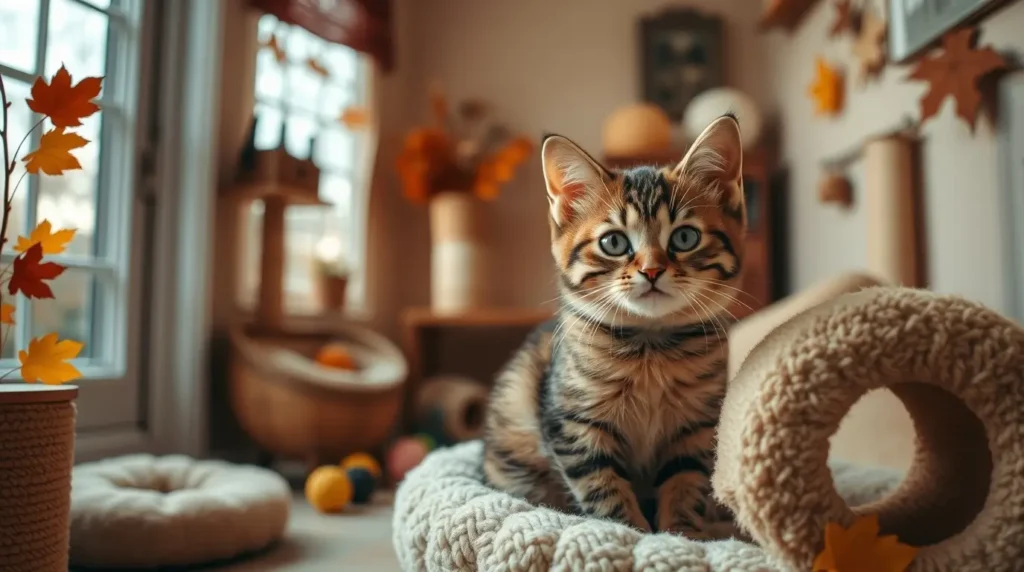When it comes to moving an outdoor cat to a small room, many pet owners worry about stress, resistance, and potential escape attempts. At Whizpet, we’ve conducted extensive research to uncover the best strategies for helping outdoor cats transition indoors. Through expert consultations, case studies, and veterinary insights, we’ve identified the most effective ways to make this adjustment smooth and stress-free.
Moving an outdoor cat to a small room is more than just bringing them inside—it’s about creating a secure, enriching space where they can feel comfortable. Our research highlights that gradual acclimation, scent familiarization, and environmental enrichment significantly improve the transition process. Additionally, patience, routine, and positive reinforcement play a key role in helping cats settle in without distress.
Outdoor cats often exhibit behavioral changes when moved indoors. Some may become anxious or restless, while others adjust quickly with the right approach. Whizpet’s research emphasizes the importance of understanding feline instincts and providing the right support. By making small but impactful adjustments, you can create a stress-free environment that helps your cat thrive indoors. This guide will walk you through proven techniques to ease this transition while ensuring your cat remains happy, engaged, and well-adjusted. Let’s dive in!

Why Moving an Outdoor Cat to a Small Room is a Smart Choice
Many cat owners choose to move their outdoor cats indoors due to safety concerns, health risks, or environmental factors. Outdoor cats are more vulnerable to accidents, predators, harsh weather, and diseases. Transitioning them to a small room first allows them to adjust gradually before exploring the rest of the house.
In addition to safety, moving an outdoor cat to a small room provides a controlled environment where they can become familiar with indoor life at their own pace. Outdoor cats are accustomed to roaming freely, so confining them suddenly can cause stress. However, by setting up a cozy, enriched space with their favorite bedding, toys, and scratching posts, they can feel more at ease.
Behavioral studies suggest that gradual confinement helps outdoor cats adapt without feeling trapped. By introducing indoor elements like climbing trees, window perches, and interactive toys, you can simulate an engaging environment that mimics their outdoor experiences. Cats also benefit from consistent meal schedules and human interaction, which helps establish trust and reduce anxiety.
Additionally, moving an outdoor cat to a small room before allowing full access to the house prevents territorial disputes with existing pets. It also helps in litter training and monitoring their health closely during the transition. With the right approach, your cat will not only adjust but thrive in its new indoor setting.
5 Proven Tips to Successfully Move an Outdoor Cat to a Small Room
1. Prepare the Room in Advance
Before bringing your cat inside, ensure the room is cat-friendly. It should be a quiet, comfortable space where they feel safe. Creating a stress-free environment is essential when moving an outdoor cat to a small room, as sudden confinement can be overwhelming. A well-prepared room will make the transition smoother and help them feel at ease.
Essentials for Moving an Outdoor Cat to a Small Room:
- Litter Box: Place it in a quiet corner and keep it clean. Outdoor cats may take time to adjust to using a litter box, so using a natural, unscented litter can make the process easier.
- Food & Water Bowls: Fresh food and water should always be available. Position them away from the litter box to maintain hygiene and encourage proper eating habits.
- Comfortable Bed: A cozy spot to sleep will help your cat feel secure. Soft, warm bedding that carries their scent can ease anxiety.
- Scratching Post & Toys: Keep them entertained and engaged. Providing scratching posts, puzzle feeders, and interactive toys will prevent boredom and destructive behaviors.
- Hiding Spots: Provide a small box or covered area where they can retreat. Outdoor cats are used to having safe hideaways, so offering enclosed spaces like cat tunnels or covered beds can make them feel more secure.
- Window Perch or Cat Tree: Cats love observing their surroundings. A perch by the window allows them to look outside safely and reduces their desire to escape.
- Pheromone Diffusers: Consider using synthetic feline pheromones to create a calming atmosphere. Products like Feliway help reduce stress and promote relaxation.
Moving an outdoor cat to a small room is all about making them feel secure while adjusting to their new indoor environment. Ensuring they have everything they need will make the transition smoother and reduce anxiety.
2. Make the Transition Gradual
Suddenly confining an outdoor cat to a small room can be overwhelming. Start by bringing them indoors for short periods and increasing the duration gradually. Moving an outdoor cat to a small room in stages helps minimize stress and resistance.
- Keep the door open initially so they don’t feel trapped. Allow them to explore at their own pace while keeping their escape routes blocked to prevent them from bolting back outside.
- Spend time with them in the room to build trust. Sitting quietly, reading, or talking softly can help them associate the space with positive experiences.
- Offer treats and positive reinforcement to encourage good behavior. Reward them when they explore the room or use their litter box.
- Use familiar scents by placing their favorite blanket or toys in the room. Cats rely heavily on scent, and having familiar smells can help them feel more at ease.
- Play with them regularly to redirect their energy. Outdoor cats are used to hunting and roaming, so engaging them with interactive toys, such as feather wands or laser pointers, can help ease their transition.
- Avoid forcing interactions if they seem hesitant. Let them come to you on their own terms to build trust.
Gradually, as they grow more comfortable, you can begin closing the door for short periods to help them adjust to being confined. The goal is to make them feel safe rather than restricted, ensuring a smooth and successful transition.
3. Use Scent Familiarization
Cats rely on their sense of smell to feel at ease. To help them adjust, moving an outdoor cat to a small room should include scent-based techniques that create familiarity and comfort.
- Bring in items with their scent, such as a blanket, bed, or even soil from outside. This helps your cat feel like the space belongs to them.
- Rub a soft cloth on their face and wipe it around the room to distribute their scent. This mimics natural territory marking, making them feel more at home.
- Use pheromone diffusers (like Feliway) to create a calming environment and reduce stress levels.
- Introduce your scent by placing an unwashed piece of clothing in their sleeping area. Your familiar smell can be reassuring.
- Rotate their bedding between the room and their previous outdoor sleeping area to merge scents gradually.
- Avoid strong artificial scents like air fresheners or cleaning chemicals, as they can be overwhelming and distressing.
By prioritizing scent familiarization, you can make moving an outdoor cat to a small room much less stressful. This method helps ease the transition by tapping into your cat’s natural instincts, allowing them to adjust with confidence and security.
4. Prevent Escape Attempts When Moving an Outdoor Cat to a Small Room
It’s natural for an outdoor cat to try to escape when confined. Here’s how to minimize this behavior:
- Secure doors and windows to prevent accidental escapes. Double-check that all possible exit points are closed and latched securely.
- Engage them with interactive play to distract from escape attempts. Wand toys, laser pointers, and feather teasers can redirect their focus and burn off excess energy.
- Keep curtains or blinds closed to reduce their desire to go outside. If they can’t see the outdoors, they may be less inclined to try to escape.
- Ensure they have a window perch so they can look outside safely. This allows them to observe their environment without feeling the urge to run away.
- Create a stimulating indoor environment by offering vertical spaces, scratching posts, and tunnels to mimic outdoor exploration.
- Use calming treats or supplements if your cat shows excessive stress or agitation. Natural calming chews or sprays can help ease anxiety during the transition.
5. Establish a Routine for a Smooth Transition
Cats thrive on routine. Sticking to a schedule will help your cat feel secure in their new environment.
- Feed them at the same time daily. Consistency in meal times helps create a sense of predictability and stability.
- Engage in play sessions to expend their energy. Providing regular physical and mental stimulation reduces stress and prevents boredom.
- Provide quiet time to help them relax and get used to their new space. Allow them time to explore without excessive interference.
- Set up designated activity times so they know when to expect play, meals, and rest. This helps regulate their energy levels.
- Keep the environment engaging with rotating toys, new scratching posts, or small treats hidden around the room to maintain interest.
- Use calming music or white noise machines to create a soothing atmosphere, reducing stress when moving an outdoor cat to a small room.
Addressing Common Concerns About Moving an Outdoor Cat to a Small Room
Is it Inhumane to Transition an Outdoor Cat to an Indoor Life?
No, as long as the transition is handled with care. Many cats adapt well to an indoor lifestyle, especially when their physical and mental needs are met. Providing stimulation, playtime, and vertical spaces can keep them happy indoors.
How to Keep an Outdoor Cat from Running Away When You Move?
- Keep them confined indoors for at least 2-4 weeks before allowing outdoor access.
- Supervise outdoor time using a cat harness or enclosed cat patio (catio).
- Use treats and toys to build positive associations with their new space.
How to Safely Move an Outdoor Cat to a New Home?
- Use a secure carrier and transport them in a quiet, stress-free manner.
- Set up a familiar environment with their favorite items.
- Keep them inside for a few weeks to prevent them from getting lost.
How to Keep an Outdoor Cat Inside at Night?
- Establish a consistent indoor bedtime routine.
- Provide nighttime enrichment (toys, climbing structures, and puzzles).
- Make the indoor space more appealing than the outdoors.
Letting Cats Out for the First Time After Moving – When Is It Safe?
- Wait at least 3-4 weeks before letting them outside.
- Supervise their first few outings and use a leash or enclosed space.
- Ensure they recognize their new home as a safe space before allowing full outdoor access.

Final Thoughts
Moving an outdoor cat to a small room requires patience, consistency, and positive reinforcement. By gradually introducing them to their new environment, preventing escape attempts, and maintaining a routine, you can make the transition smooth and stress-free. Remember, every cat is different—some may adapt quickly, while others need more time.
Call to Action:
Are you in the process of moving an outdoor cat to a small room? Share your experience in the comments below! Need more cat care tips? Subscribe to our newsletter for expert advice and pet-friendly insights!
Related blog: For more detailed information about pet care


Pingback: How Can I Tell If My Cat Has a Ringworm? Quick & Easy